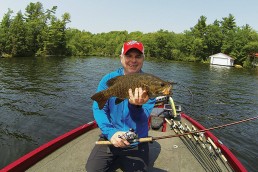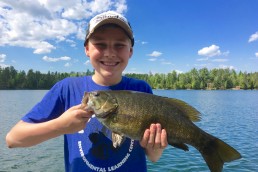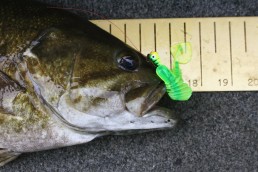Choice Topwaters for Canadian Smallmouths: Chug, Prop or Walk Next Summer
SHARE THIS POST
The only thing more enjoyable than watching a topwater work its magic, is witnessing a smallmouth smashing one on the surface. Smallmouths are restless, particularly the large ones. Topwater prey draw on their curiosity, and the desire to eat an easy meal. Topwater lures are fun and effective all summer long. And learning to work them and discovering which one will work best for your fishing conditions you’re in next year is not a deep secret.
Here’s a guide to using three top smallmouth topwaters when you make that trip to Canada.
Pop or chug it
Chug, chug, chug—they go across the surface, calling smallmouths to them. Poppers, often called chuggers, are sentimental favorites.
Ranging from 2 1/2 to 4 inches in length, an ideal popper is compact, hefty and sport a sticky, sharp-feathered rear treble. Chuggers have the widest and deepest mouths, creating the loudest, slurping chugs. A deep concave face permits the slowest retrieves while moving the maximum amount of water. Suited for aiming at targets, they’ll call bass out of cover or out of a “sleepy” mood.
Poppers are designed to be a quick lure that allows for fan-casting. The finest poppers have a very shallow lower jaw, allowing it to zip along the surface as a cadence of snapping the rod tip and reeling is worked. Usually fished over shallow waters, poppers are equally effective far off the bank up to 15 feet and even beyond if smallmouths start schooling. A heavy chop cancels its effectiveness, but stubborn anglers can make it work under poor water conditions.
If you’re still planning a trip next summer for northern smallies up north, Josh Peacock of Kenora prefers a popper in midsummer around cabbage weeds and specific targets like docks and wood. He’s a fan of a locally made cedar popper by Rockpile Lures. Handcrafted in Kenora, this popper has tempted many big smallmouths. Shad patterns are Josh’s go-to colors, but Rockpile’s owner Ron Achilles has had great luck on wildly painted versions. This cedar popper is light, so Josh opts for a medium-light St. Croix Legend Tournament casting rod. This rod action might seem too whippy, but he assures that this rod action is perfect for controlling wild fish, which can pull free of treble hooks.
Peacock’s approach isn’t limited to northern bass. Warsaw, Ont. resident Chris Giles agrees with fishing targets like boulders, isolated logs or corners of docks. But usually you’ll find Giles working a SK-Pop Grande or Skitter Pop in natural hues along transitions in 4 to 9 feet of water. Where rocks, weeds or sand merges, smallmouths will focus there throughout the summer. He’ll also fling casts over shallow shoals, tuffs of weeds and sand flats.
Chris finds this approach works right across the southern portion of the province if you want to choose Lower Ontario to fish next year.
“Anywhere from Ottawa to North Bay and down to Toronto, this presentation will work on smallmouths,” Giles assures.
Giles also advises anglers to adopt baitcasting gear, even with light poppers. Casting distance isn’t hindered, and he finds it much easier to work all his topwater baits. His rod of preference is a G. Loomis IMX 802C TWR Rod matched with a Shimano Curado 200i with a 7.2:1 gear ratio. This setup offers greater control, and the speedy reel scoops up slack line during the retrieve with ease.
On weedy lakes, floating strands of grass collect on the bait, killing its action. When encountering this problem, Chris opts for a big popper so he can clear annoying weeds with a brisk snap.
Walking the walk
The 3- to 5-inch minnow-shaped lure gets its identity from the walking action it produces. With blueprints stemming from the legendary Zara Spook, modern baits are sleek and meticulously painted. Bring them to life with a “walking-the-dog” retrieve, which requires a marriage of short rod jerks, minor reel cranks and a bit of slack line.
Are you enjoying this post?
You can be among the first to get the latest info on where to go, what to use and how to use it!
Peacock is a big fan of the Lucky Craft Sammy 100 for summer in Canada, as shield-lake smallmouths venture into deep water and focus on nomadic baitfish.
“In early July, when the smallmouths leave the spawning areas and focus on eating smelts around islands in 14 to 25 feet of water, I use the Sammy,” Peacock says. “A Sammy is good in post-spawn conditions, and early July for a few reasons. Fish are lethargic after the spawn and are spread out. A Sammy covers a lot of water and offers fish a big meal.”
Josh’s gear consists of a St. Croix Legend Tournament Topwater Casting Rod and 12- to 14-pound-test monofilament line. He prefers the forgiveness and stretch, as well as the low cost of monofilament.
Chris Giles also is a fan of the 6-foot 8-inch rod.
“I’m short, so anything over 7 feet I tend to hit the water with the rod tip,” Giles said, laughing.
His favorite walking bait is the Jackall Bonnie, in either their Aurora Black or Golden Shiner.
Considered a big-fish lure, a walking bait is a perfect fit for one member of a two-person tournament team where one big smallmouth can help grab the trophy. Anglers in the Great Lakes favor this style of topwater, as its size grabs the attention of monster smallmouths. Also, it works well across most water conditions, even when waves washout other topwater presentations.
Winging it with prop baits
Sporting propellers at the nose and tail or a single rear prop, this minnow-shaped bait can range from painstakingly slow splashes to ripping retrieves. To produce pronounced gurgles, bend both wings of the props forward to create maximum resistance, which is ideal for coaxing reluctant biters from cover. Bending the prop blades slightly backward will decrease the resistance, allowing the bait to skitter in short bursts along the surface. This makes it ideal for fan-casting flats or shorelines.
They also work for annoying shallow smallmouths that need “calling” down to them as they lurk well out of sight. Again, larger baits can be difficult to swallow whole, so keep hooks razor-sharp.
Giles has discovered a new bait that offers a twist. The Jackall Bitsy, complete with a belly blade, creates extra flash and vibration. Giles likes how it aerates the water and finds it superior when the wind has stirred the bottom.
One trick to ensure these baits work effortlessly is to use heavier monofilament. The wiry line rarely fouls the front prop, whereas thinner lines, especially braid, will snare constantly. Giles uses straight 15-pound-test mono, and finds the thicker line doesn’t detract from his success. In fact, monofilament rules when it comes to all topwaters. It offers a better balance of stretch and floating qualities over other lines. Interested in trying something new? Have a look at floating mono that’s popular with stream anglers in Canada and beyond.
Experiment between each lure style and let the fish’s mood determine which one is best. Learning to use topwaters properly will keep you in bass all season, especially if you decide to plan now to go fish in Ontario next summer.
MWO
SHARE THIS POST
Did you enjoy this post?
You can be among the first to get the latest info on where to go, what to use and how to use it!
Luigi De Rose
Luigi De Rose, has been crafting articles for the last 25 years. Loving anything fishing, especially bass fishing, Luigi has been lucky enough to fish on three continents. Currently, he is the bass editor at Ontario OUT of DOORS magazine and owner of IBASSIN.com, a blog decided to all things bass. His articles have graced the pages of Bassmaster, In-Fisherman and MidWest Outdoors to name a few. When not fishing, you can find him with his two girls and wife in the outdoors.



